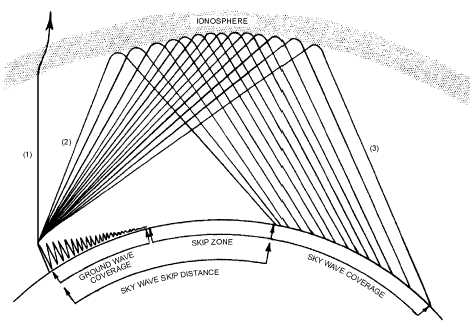Skip Zone: Difference between revisions
TheAnarcat (talk | contribs) (New page: See Wikipedia:Skip zone.) |
(added info from wikipedia diagram, and related wiki pages) |
||
| Line 1: | Line 1: | ||
'''Related wiki pages''': [[Propagation]], [[Sunspot Cycle]], [[Tropospheric ducting]]. | |||
Extracted from [[Wikipedia:Skip zone]]. | |||
A skip zone, also called a silent zone or zone of silence, is a region where a radio transmission can not be received located between regions both nearer and further from the transmitter where reception is possible. | |||
[[Image:skipzone.jpg |550px]] | |||
When using medium to high frequency radio telecommunication, there are radio waves which travel both parallel to the ground, and towards the ionosphere, referred to as a ground wave and sky wave, respectively. A skip zone is an annular region between the furthest points at which the ground wave can be received and the nearest point at which the refracted sky waves can be received. Within this region, no signal can be received as there are no radio waves to receive. | |||
The skip zone can be diminished by increasing the number of directions in which the skywave is transmitted or by decreasing the refractive angle of the skywave. Another factor which will affect skip zones is the width of the ionosphere. This can be affected by sun spots, solar flares or whether it is day or night. The more solar radiation, the wider the ionosphere becomes. A wider ionosphere will cause the sky wave to refract closer to the Earth thus diminishing the size of the Skip Zone while absorbing the strength of the signal. Transmitting at night is most effective for long distance communication but the skip zone becomes significantly larger. Very high frequency waves and higher travel through the ionosphere and therefore generate no skip zone but again have a limited range. | |||
If the radio wave frequency is decreased, a point is reached where all waves (even vertically incident waves) are reflected back to the Earth. | |||
Another method of decreasing the skip zone is by decreasing the frequency of the radio waves. Decreasing the frequency is akin to increasing the ionospheric width. A point is eventually reached when decreasing the frequency results in a zero distance skip zone. In other words, a frequency exists for which vertically incidence radio waves will always be refracted back to the Earth. This frequency is equivalent to the ionospheric plasma frequency and is also known as the ionospheric critical frequency, or foF2. | |||
Latest revision as of 23:21, 4 November 2010
Related wiki pages: Propagation, Sunspot Cycle, Tropospheric ducting.
Extracted from Wikipedia:Skip zone.
A skip zone, also called a silent zone or zone of silence, is a region where a radio transmission can not be received located between regions both nearer and further from the transmitter where reception is possible.
When using medium to high frequency radio telecommunication, there are radio waves which travel both parallel to the ground, and towards the ionosphere, referred to as a ground wave and sky wave, respectively. A skip zone is an annular region between the furthest points at which the ground wave can be received and the nearest point at which the refracted sky waves can be received. Within this region, no signal can be received as there are no radio waves to receive.
The skip zone can be diminished by increasing the number of directions in which the skywave is transmitted or by decreasing the refractive angle of the skywave. Another factor which will affect skip zones is the width of the ionosphere. This can be affected by sun spots, solar flares or whether it is day or night. The more solar radiation, the wider the ionosphere becomes. A wider ionosphere will cause the sky wave to refract closer to the Earth thus diminishing the size of the Skip Zone while absorbing the strength of the signal. Transmitting at night is most effective for long distance communication but the skip zone becomes significantly larger. Very high frequency waves and higher travel through the ionosphere and therefore generate no skip zone but again have a limited range. If the radio wave frequency is decreased, a point is reached where all waves (even vertically incident waves) are reflected back to the Earth.
Another method of decreasing the skip zone is by decreasing the frequency of the radio waves. Decreasing the frequency is akin to increasing the ionospheric width. A point is eventually reached when decreasing the frequency results in a zero distance skip zone. In other words, a frequency exists for which vertically incidence radio waves will always be refracted back to the Earth. This frequency is equivalent to the ionospheric plasma frequency and is also known as the ionospheric critical frequency, or foF2.
